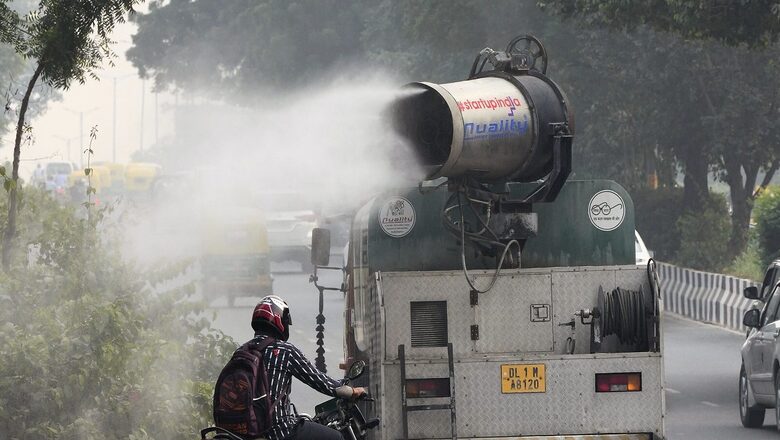
views
The Delhi government, in a recent order to step up the fight against air pollution under Stage-I, II and III of the Graded Response Action Plan (GRAP), has asked agencies to intensify the use of anti-smog guns at construction sites and key stretches to control dust emissions. The huge machines set atop a vehicle expelling fine water droplets can be spotted at key junctions across the city.
Last January, installation of these devices was made mandatory at construction and demolition sites in Delhi-NCR with more than 20,000 square metres built-up area and essentially requiring environment clearance for the work. This was after the Central Pollution Control Board (CPCB) and the Delhi Pollution Control Committee (DPCC) had submitted reports of the efficacy of smog guns in the apex court.
As Delhi banks on the anti-smog guns, News18 takes a look at how these devices work and what difference they can make to cleaning the air around us:
The method
Delhi’s pollution-control officials explained that anti-smog guns spew fine, atomised water droplets through high-pressure propellers in the air, making a canopy effect and helping air particles get increased mass and settle by inertia. The device uses high-pressure water fogging with turbo air flow, which creates an ultra-fine fog consisting of very fine water droplets (30-50 micron size). These tiny water droplets absorb the smallest dust particles in the air, yet fall to the ground without wetness.
These water droplets suppress the particulate matter — PM10 and PM2.5, which are the most prominent pollutants in Delhi’s air — and help cleanse the air.
“It is alternately called a spray gun or a water cannon and is suitable for settling localised dust in a work-zone. However, it may not be as effective in large open areas or those with heavy and regular traffic volume,” said a senior official who did not wish to be named.
How much the device is able to control dust emissions also depends on the availability and quantity of water used. “In urban areas, the device may use 40 litres to 250 litres of water per minute. Sourcing and quality of water intake happen to be important factors, which need to be pre-planned. Water should be free from coliform or bacteria,” the official said.
Zone of influence
According to the working principle laid down by DPCC, water-throw distance is an important criterion for successfully suppressing dust in the said area. Anti-smog guns having a throwing capacity of 50 metres can cover an area of about 7,000-8,000 square metres at a time while those with a capacity of 100 metres can cover an area of about 27,000- 31,000 square metres.
Environmental experts said while anti-smog guns can be installed and are effective at construction projects to minimise PM10 (coarse particles, mainly generated from dust), when put on roads with heavy vehicular emissions, which is mainly PM2.5, it’s not of much use.
Expert speak
According to Prof SK Singh, Vice-Chancellor, Rajasthan Technical University Kota (Rajasthan) and former head of environmental engineering, Delhi Technological University (DTU), said the air quality index (AQI) that is calculated to assess polluted air is made up of how high particulate matter (PM) concentration is in the atmosphere.
“While anti-smog guns can be effective in suppressing the particulate matter in enclosed spaces such as construction sites, it is not successful in controlling on-road emissions, which are continuous and in a larger open area having other local pollutants as well. Even if it cleans up the air on a busy stretch to some distance, its results are diluted with more pollution getting generated at the same time,” he said.
The only solution for combating air pollution in Delhi-NCR is to bring down the emissions from all sources. Once emissions are released, there is no effective tool or technology available to control them or minimise them and devices such as anti-smog guns or smog towers just have a limited range of action. Controlling emissions at the source is key to clean air, said Singh.
Read all the Latest India News here




















Comments
0 comment